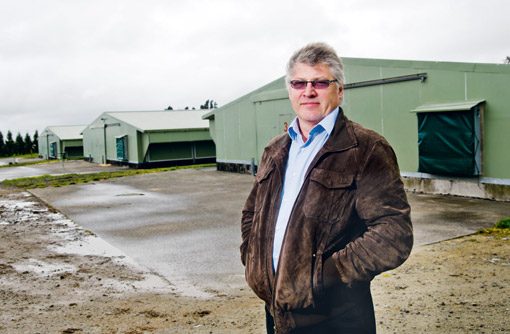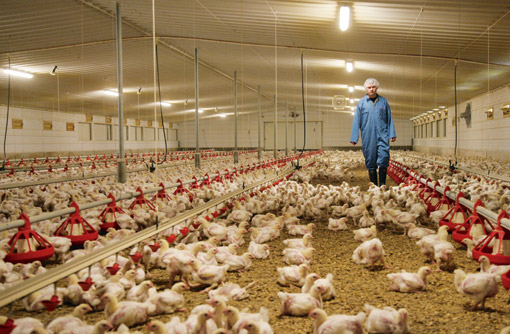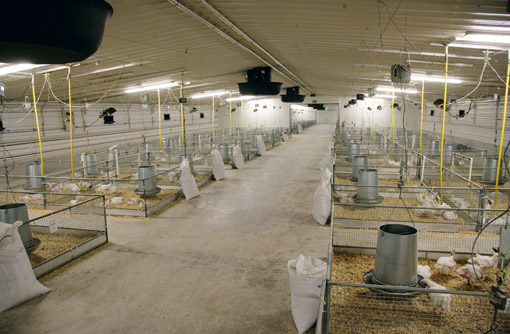Kiwi broilers achieve world-beating performance

Having the lowest FCR in the world is quite a claim. But somebody has to have it and, looking at the way Tegel Poultry is run, it is perhaps not surprising it holds that title.
The ratio for the company as a whole averages just 1:5 across its 90 or so contracted broiler farms, with a typical range from 1:45 to 1:65 at 2.3kg. Average processing weight is 2.5kg.
Agriculture manager Bill Williams says there are five key pillars, all of which have to be fine-tuned and optimised to deliver this world-beating performance.
The five pillars
The first of these is genetic selection. “We are looking for a balance between production traits – low FCR, high meat yield and growth rate – and welfare traits, such as good leg strength and low mortality,” says Mr Williams. “There is some trade-off in breeder performance for top broiler performance.”
The company has used the Ross breed exclusively since 1974. FCR has improved by 1.5 points each year for the past 10 years, and liveweights by 50g a year. Mr Williams anticipates even bigger gains in genetic potential over the next five years.
The second pillar is nutrition and here Tegel Poultry is paying particularly close attention to feeding birds right in the early stages. “The first catch of female birds is at about 31 days, when they weigh 1.75kg, but as growth rate continues to improve over time, the starter diet becomes even more important.”
The company also uses a combination of EFG (Emmans, Fisher and Gous) modelling software, laboratory analysis, feeding trials and veterinary feedback to optimise its poultry rations. “The spec of the diet in protein and energy terms impacts directly on FCR, so the highest spec diet that can be managed in the shed at the optimum dressed weight cost to the plant is the objective.”
Getting the feed texture right is also important to maximise intakes with minimum effort for the bird.

Feed procurement is an integral part of this strategy, with raw materials sourced to deliver this optimum outcome for the business.
“Typically, New Zealand feed wheat is most cost effective for the Christchurch region, but is highly variable in quality,” says Mr Williams. “Imported wheat and sorghum from Australia, which tends to be more consistent in nutrient value, is used in our North Island plants, with soya bean meal typically sourced from South America.”
Dealing with high costs and volatility are a constant challenge, so the company routinely hedges both the currency and the commodity supply period. Volatility in terms of raw material quality is managed by pre-purchase and on-arrival testing, and by streaming the use of ingredients to manage in-feed nutrient levels.
The fourth pillar Tegel Poultry focuses on is disease control, though the company is blessed with New Zealand’s naturally low disease status. The country has no Infectious Bursal Disease, no Newcastle disease and no avian influenza. “There is nothing to vaccinate against.”
The main challenges come from femoral head necrosis – “the most common cause of mortality” – coccidiosis and dysbacteriosis.
The company has recently started employing the “seed, feed and weed” strategy to optimise gut health (see Poultry World, December 2012issue), to maximise the presence of beneficial bacteria in the gut, and so fight off infections.
The final pillar is animal husbandry, covering everything from chick placement and planning, to shed management, biosecurity and grower attitude.
Asked how he would define “best practice”, Mr Williams says attention to detail in every aspect of the shed environment is the key to great performance. “The best growers typically spend more time in-shed assessing and managing the birds’ requirements than average growers.”
The company’s aim is to move any below-par producers closer to the top performers through a combination of shed improvement, training, support and better information availability, and so drive FCR lower still.
Other factors

While the clearly defined and well-communicated “five pillar” strategy is instrumental in extracting an exceptional FCR, there are certain other factors at play.
Shed design and condition are clearly important. “We specify every aspect of shed design. Ease of cleaning is crucial, with concrete floors and aprons, washable internal surfaces and elimination of unwanted water ingress,” says Mr Williams.
“Ventilation needs constant review to meet the birds’ changing requirements – tunnel is preferred. And the buildings must have effective insulation and sufficient heating capability for brooding.”
Stocking rates are no higher than those on any British farm, with a welfare code limiting broilers to 38kg/sq m maximum at any time.
The birds are also regularly thinned, with a first catch at around 1.75kg, then again at 2.2kg and maybe a third at 2.8kg.
“This means that later in-shed densities are usually well below welfare limits.”
But there is a more relaxed approach to feed additives than in the UK and Europe.
While growth promoting hormones have never been used in New Zealand and are illegal, there is no restriction on antibiotics for prophylactic or digestive enhancement. “At Tegel, we use low levels of antibiotic and non-antibiotic feed enhancers to control enteric diseases,” says Mr Williams.
Lighting is also more conducive to faster growth than on UK farms. “The welfare code requires at least four hours of darkness per day and a minimum of three hours continuous darkness per dark period,” Mr Williams explains.
“Lighting intensity is usually lowered, but will always enable birds to see each other and their surroundings. Light programs are used to stimulate activity.”
Another significant factor in delivering better performance is the company’s new pricing structure.
Tegel has moved away from a traditional integrator payment system, whereby the grower would be paid a fee for producing each factory-ready bird, to one where the grower is paid on a per square metre basis.
The new model provides for greater flexibility in shed use for the company, while ensuring a more consistent income for the grower – regardless of how the shed is used.
“In some ways the contracted grower now acts as both a landlord, leasing shed space to the company, and a farm manager, who is paid according to how much the shed is used as determined by the length of the cycle and the number of cycles a year,” explains Mr Williams.
They are also incentivised according to the standard of the shed and how well they achieve the desired outcomes from each batch of birds.
“This new approach has provided a win-win for the company and our growers, allowing us to work closer to achieve a common goal of constantly improved performance.”
Keep up with the latest poultry news
